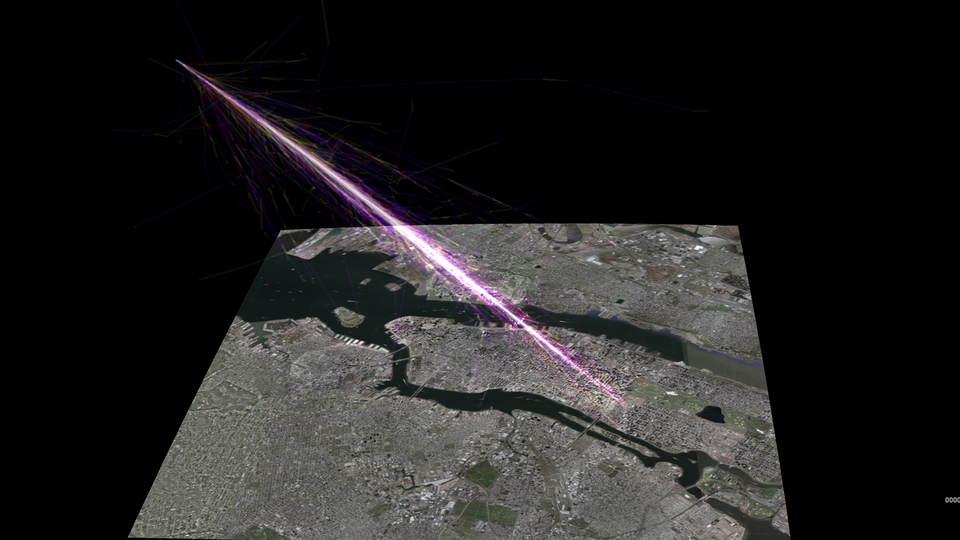Bowling at (Nearly) the Speed of Light!

The accompanying image shows data for a simulated cosmic ray shower occurring over New York City, courtesy of the University of Chicago COSMUS Project.
Believe it or not, we are under constant bombardment from space! Cosmic rays are tiny particles that fly through the Universe at nearly the speed of light. They’re slamming into Earth all the time, but where do they come from? New observations are helping answer that question.
First, a few basics about cosmic rays. Approximately 99 percent of these particles are atomic nuclei stripped of their electrons—the remaining 1 percent consists almost entirely of solitaryelectrons. And a very small number are believed to be antimatter particles.
Cosmic rays carry energy—enough energy to cause health problems or to turn people into fictional superheroes. Most of the energy in a cosmic ray is due to the kinetic energy of the particle, which depends on the mass of the particle (more massive particles carry more energy) and the speed of the particle (faster particles carry more energy). And the amount of energy increases exponentially with velocity, growing ginormous as the particle approaches the speed of light.
Multiple processes can create the cosmic rays that we observe on Earth. Our own star, the Sun, produces particles called solar energetic particles, often during a solar flare. But some cosmic rays are observed to possess a billion times more energy than solar particles—they’re moving crazy fast! So where do they come from?
Earlier this month, researchers at the Pierre Auger Observatory in Argentina completed analysis of 30,000 high energy (greater than 8 EeV) particles observed between 2004 and 2016. From these measurements, the team could confirm that most high energy cosmic rays come from beyond our Milky Way galaxy.
So exactly how did the team detect individual atomic nuclei? Actually, they didn’t! When a cosmic ray enters the atmosphere, it may strike an air molecule, such as nitrogen or carbon dioxide. That collision results in the protons and neutrons making up each atomic nucleus to break up into quarks, which then re-form in various combinations. Because momentum is conserved, the average momentum of all particles will match the original cosmic ray. Since we now have multiple high energy secondary rays, a chain reaction occurs resulting in billions of detectable particles called an air shower or cascade.
In addition to the cascade, as the particles travel through the atmosphere, they emit three types of radiation.
First off, fluorescence occurs when an atom’s energized electrons release a photon as they return to a lower energy ground state. For cosmic rays, the fluorescence produced is due to nitrogen molecules in the atmosphere becoming energized by other particles in the cascade.
Second, Cherenkov radiation is produced when a particle exceeds the speed of light in an environment. While nothing can exceed the speed of light in a vacuum, light slows down when it travels through any material. In Earth’s atmosphere, light is slowed by 0.03 percent, which is just enough that the most energetic cosmic rays feel the need to honk their horns to get light to move out of the way. This movement disturbs the magnetic field and the shock wave that occurs in the wake of the particle produces the Cherenkov radiation. This is like a sonic boom that occurs when an airplane exceeds the speed of sound.
Finally, radio waves are emitted when Earth’s magnetic field deflects the paths of electrons and positrons in the cascade.
Each of these types of radiation can be detected by standard optical and radio telescopes. What the Pierre Auger Observatory adds is the detection of the actual cascade of particles falling through the atmosphere.
Over 1,500 Cherenkov detectors were constructed in a hexagonal grid over 1,160 square miles of western Argentina. (Don’t be fooled by the name. These detectors don’t detect Cherenkov radiation released in the atmosphere; instead, they use Cherenkov radiation to identify particles that enter the detector.) Each detector is a plastic tank containing twelve tons of water with sensors to measure Cherenkov radiation emitted within the tank. Since the speed of light in water is 75 percent of its speed in a vacuum, the tanks can also detect lower energy secondary rays (a.k.a. the cascade).
As particles in the cascade reach the array of detectors, the energy level and arrival time of each ray is recorded. From this record, the team can calculate the direction that the initial cosmic ray entered Earth’s atmosphere!
We can look at this entire process like a bowling alley. The ball represents a cosmic ray, which hurtles down the lane until it strikes the pins, which represent the atmosphere. After the pins fall, the bowling computer plays the role of the observatory, and by looking at which pins are still standing, can tell you where your shot came from!
Unfortunately, this only tells us where the ray entered Earth’s atmosphere, but not where in space it originated. Because cosmic rays are charged particles, their path can be deflected by interacting with a magnetic field. The Milky Way Galaxy that we live in has a powerful and complex magnetic field, and is believed to bend the path of cosmic rays by tens of degrees.
Although this means we cannot point to a specific source for a given ray, we can identify regions in the sky where more rays originate. Observations from the Pierre Auger Collaboration have produced a density map of arriving cosmic rays. The map has two major properties: First, it is anisotropic, which means that the arrival direction of cosmic rays are not evenly distributed. Second, the distribution peaks at a point 120 degrees above the galactic center, making it unlikely that the source of high energy cosmic rays is within our galaxy.
Now that scientists understand that our own galactic center is not the source of most rays, it will help narrow the search as more observations become available!